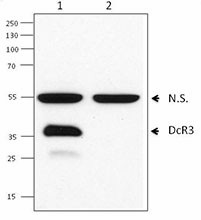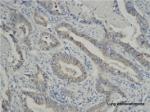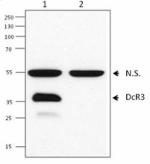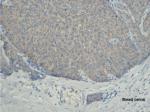- Clone
- B08-35 (See other available formats)
- Regulatory Status
- RUO
- Other Names
- Decoy receptor 3, TR6, M68
- Isotype
- Mouse IgG1, κ
- Ave. Rating
- Submit a Review
- Product Citations
- publications

-

Western blot analysis of HCT-116 cells (lane 1) and Hela cells (lane 2) using DcR3 antibody (clone B08-35). -

-

Formalin-fixed, paraffin-embedded human tissues were stained with 5 µg/ml B08-35, followed by incubation with biotinylated goat anti-mouse secondary antibody, followed by HRP-streptavidin. Staining was visualized with DAB peroxidase substrate and counterstained with hematoxylin. Immunohistochemical staining of DcR3 expression is shown for human breast cancer (TOP) and lung adenocarcinoma (BOTTOM).
| Cat # | Size | Price | Quantity Check Availability | Save | ||
|---|---|---|---|---|---|---|
| 333202 | 100 µg | 206 CHF | ||||
The DcR3 protein is a soluble member of the TNF receptor superfamily containing four TNF receptor domains with an approximate molecular weight of 35 kD. DcR3, also known as Decoy receptor 3, TR6, M68, can be secreted by monocytes and myeloid-derived dendritic cells following exposure to bacterial antigens. DcR3 is overexpressed in tumors including lung and colon cancers, gliomas, and pancreatic cancers and can be detected in the serum of cancer patients. DcR3 can also be found in the cytoplasm and endoplasmic reticulum in some cell types. This protein competes for ligand binding with cell surface receptor and can inhibit their signaling. DcR3 has been shown to bind the ligands FasL, LIGHT, and TNF like molecule 1 (TL1A) to inhibit binding to the cell surface receptors Fas, HVEM and LT-ßR, and death receptor 3 (DR3), respectively.
Product DetailsProduct Details
- Verified Reactivity
- Human
- Antibody Type
- Monoclonal
- Host Species
- Mouse
- Immunogen
- Human DcR3 Fc protein
- Formulation
- Phosphate-buffered solution, pH 7.2, containing 0.09% sodium azide.
- Preparation
- The antibody was purified by affinity chromatography.
- Concentration
- 0.5 mg/ml
- Storage & Handling
- The antibody solution should be stored undiluted between 2°C and 8°C.
- Application
-
WB - Quality tested
IP, IHC - Reported in the literature, not verified in house - Recommended Usage
-
Each lot of this antibody is quality control tested by Western blotting. For Western blotting, suggested working dilution(s): Use 5-20 µg antibody per 5 ml antibody dilution buffer for each mini-gel. It is recommended that the reagent be titrated for optimal performance for each application.
- Application Notes
-
Additional reported applications (for the relevant formats) include: Western blotting1, immunoprecipitation2, and immunohistochemistry2.
-
Application References
(PubMed link indicates BioLegend citation) -
- Hsu TL, et al. 2005. J. Immunol. 175:5135. (WB)
- Personal communication (IP IHC ELISA Detection)
- Tai SK, et al. 2012. J. Immunol. 188:2464. PubMed.
- Product Citations
-
- RRID
-
AB_2207467 (BioLegend Cat. No. 333202)
Antigen Details
- Structure
- Soluble member of the TNF superfamily (6B), contains four TNF-receptor like domains, approximate molecular weight 35 kD.
- Distribution
-
Secreted protein, also found in cytoplasm and endoplasmic reticulum. Expressed by monocytes and myeloid-derived dendritic cells following exposure to bacterial antigens. Overexpressed in tumors including lung and colon cancers, gliomas and pancreatic canc
- Function
- Competes with ligand binding to surface receptors including FasL binding to Fas, LIGHT binding to HVEM and LT-ßR, and TNF like molecule 1 (TL1A) with death receptor 3 (DR3). Competition inhibits cell-surface receptor signaling.
- Interaction
- Binds FasL, LIGHT, and TL1A
- Cell Type
- Monocytes, Dendritic cells
- Biology Area
- Apoptosis/Tumor Suppressors/Cell Death, Cell Biology, Immunology
- Molecular Family
- Cytokine/Chemokine Receptors
- Antigen References
-
1. Pitti RM, et al. 1998. Nature 396:699.
2. Bai C, et al. 2000. Proc. Natl. Acad. Sci. USA 97:1230.
3. Yu KY, et al. 1999. J. Biol. Chem. 274:13733.
4. Migone TS, et al. 2002. Immunity 16:479. - Gene ID
- 8771 View all products for this Gene ID
- UniProt
- View information about DcR3 on UniProt.org
Related FAQs
Other Formats
View All DcR3 Reagents Request Custom Conjugation| Description | Clone | Applications |
|---|---|---|
| Purified anti-human DcR3 | B08-35 | WB,IP,IHC |
Compare Data Across All Formats
This data display is provided for general comparisons between formats.
Your actual data may vary due to variations in samples, target cells, instruments and their settings, staining conditions, and other factors.
If you need assistance with selecting the best format contact our expert technical support team.
 Login / Register
Login / Register 










Follow Us